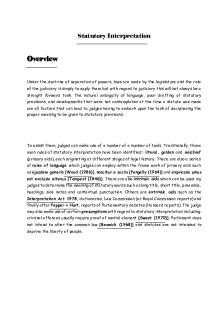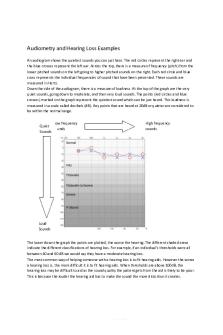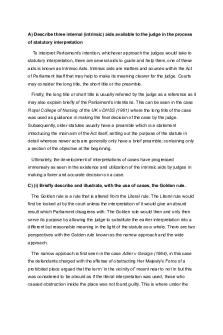Geekymedics.com-Abdominal X-ray Interpretation PDF

| Title | Geekymedics.com-Abdominal X-ray Interpretation |
|---|---|
| Course | Rural Sociology and Agricultural Extension |
| Institution | Tamale Polytechnic |
| Pages | 9 |
| File Size | 474 KB |
| File Type | |
| Total Downloads | 100 |
| Total Views | 159 |
Summary
technology...
Description
Abdominal X-ray Interpretation geekymedics.com/abdominal-x-ray-interpretation/ Posted by Daniel Ward and Dr Lewis Potter | Data Interpretation , General surgery , Radiology
June 8, 2016
Abdominal X-rays (AXR) are a frequently performed radiological investigation that you’ll be expected to be capable of interpreting. Therefore it’s essential that you develop the ability to interpret abdominal x-rays and recognise pathology. Confirm details Image quality Bowel/other organs Bones Calcification/artifact Presenting
Confirm details Always begin by checking the following: Patient details (name / DOB) Date and time the film was taken Any previous imaging (useful for comparison)
Assess image type and quality Projection of image 1/9
Anterior-posterior (AP) – either supine or erect
Exposure of image Ensure the whole abdomen is visible from diaphragm to pelvis. Quality of the image is often poor, with overlying bowel obscuring more posterior structures. If bowel perforation is being considered, you don’t usually require an abdominal film, instead you need an erect chest x-ray, as this allows free gas under the diaphragm to be identified (the patient needs to have sat upright for at least 15-20 minutes prior to the xray to allow time for air to rise).
Abdominal XR interpretation (BBC approach) It’s important to have a systematic approach to interpreting abdominal X-rays as this reduces the risk of missing pathology. In this guide we use the BBC approach: Bowel and other organs Bones Calcification and artefact
Bowel and other organs Small and large bowel Differentiating between the small and large bowel on an AXR is not always straightforward but there are a number of clues that can help you: The small bowel usually lies more centrally, with the large bowel framing it around the periphery. The small bowel’s mucosal folds are called valvulae conniventes and are seen across the full width of the bowel. The large bowel wall features pouches or sacculation that protrude into the lumen that are known as haustra. In between the haustra are spaces known as plicae semilunaris. The haustra are thicker than the valvulae conniventes of the small bowel. They also commonly do not appear to completely traverse the bowel. This distinction is unfortunately unreliable as dilated large bowel can have a haustral pattern that does in fact traverse the bowel. Faeces have a mottled appearance and are most often seen in the colon, due to trapped gas within solid faeces. There is considerable normal variation in the distribution of bowel gas. The normal diameter of the intestines on an AXR do not usually exceed: 2/9
3 cm for small bowel 6 cm for colon (large bowel) 9 cm for caecum This is often referred to as the ‘3/6/9 rule’ A normal AXR showing large bowel (white arrow) framing the small bowel (black arrow) 5 Example of faeces and it’s typical mottled appearance 7
The small bowel’s mucosal folds are called valvulae conniventes and cross the full width of the bowel 5 Haustra (white arrow) and plicae semilunaris (black arrow) 5
Small bowel obstruction Small bowel obstruction can be visualised on an AXR as dilatation of the small bowel (>3cm). The valvulae conniventes are much more visible and have what is referred to as a “coiled spring appearance”. The most common cause (75%) of small bowel obstruction in the developed world is adhesions (mostly relating to previous abdominal surgery). Some other causes include abdominal hernias (10%) and either intrinsic or extrinsic compression by neoplastic masses. 9 You should inspect the inguinal regions on the x-ray if considering a hernia as a cause of small bowel obstruction, as they are often fairly obvious even on plain abdominal x-rays Large bowel obstruction The most common causes of large bowel obstruction are colorectal carcinoma and diverticular strictures. Less common causes are hernias and volvulus. 3/9
Volvulus is a twisting of the bowel on its mesentery and most commonly occurs at the sigmoid colon or caecum. Patients with volvulus are at high risk of bowel perforation and/or bowel ischaemia secondary to vascular compromise. Sigmoid volvulus has a characteristic ‘coffee bean’ appearance Small bowel obstruction (note the dilated loops of small bowel giving a “coiled spring” appearance). Caecal volvulus is often described as having a fetal appearance Large bowel obstruction 1 Sigmoid volvulus 8
Rigler’s (double wall) sign Normally only the inner wall of the bowel is visible on an AXR. Pneumoperitoneum may cause both sides of the bowel wall to be visible. Causes of pneumoperitoneum include a perforated abdominal viscus (e.g. perforated bowel, perforated duodenal ulcer) and recent abdominal surgery. You should look closely for air under the diaphragm on an erect CXR if you suspect pneumoperitoneum. Rigler’s sign
2
Pneumoperitoneum (free 8 gas under diaphragm)
Features of inflammatory bowel disease on AXR Thumb-printing – mucosal thickening of the haustra due to inflammation and oedema causing them to appear like thumb prints projecting into the lumen Lead-pipe (featureless) colon – loss of normal haustral markings secondary to chronic colitis Toxic megacolon – colonic dilatation without obstruction associated with colitis 4/9
Toxic megacolon in a patient with ulcerative colitis. Note the lead-pipe colon with loss of normal haustral folds due to chronic colitis. 6
Other organs and structures Although AXR isn’t well suited to imaging these structures, it’s useful to recognise them to help orientate yourself and spot relevant pathology. Lungs – check the lung bases if visible for pathology (e.g. consolidation) as abdominal pain can sometimes be caused by basal pneumonia Liver – large right upper quadrant (RUQ) structure Gallbladder – rarely seen, look for calcified gallstones and cholecystectomy clips Stomach – left upper quadrant (LUQ) to midline structure, containing a variable amount of air Psoas muscles – lateral edge marked by a relatively straight line either side of the lumbar vertebrae and sacrum Kidneys – often visible, right lower than left due to the liver Spleen – LUQ, superior to left kidney Bladder – variable appearance depending on fullness
5/9
Other structures visible on AXR
Bones Lots of bones are visible on an AXR and it’s important that you can identify each and screen for any pathology (which may be expected or unexpected). In addition, bones on the AXR provide useful landmarks for where you might expect to see a soft tissue structure (e.g. ischial spines are the usual level of the vesico-ureteric junction). Bones commonly visible on AXR include: Ribs Lumbar vertebrae Sacrum Coccyx Pelvis Proximal femurs A wide range of bony pathologies can be identified on abdominal x-rays including fractures, osteoarthritis, Paget’s disease and bony metastases.
6/9
Sclerotic bony metastases (arrows) in a male patient with prostate cancer. 3
Calcification and artefact Various high density (white) areas of calcification or artefact may be seen. Examples include: Calcified gallstones in the RUQ Renal stones/staghorn calculi Pancreatic calcification Vascular calcification Costochondral calcification Contrast (e.g. following a barium meal) Surgical clips Naval jewellery artefact over the approximate location of the umbilicus Abdominal X-Ray showing ureteric stent placement. Staghorn calculus on the left and multiple renal stones on the right. 4 Belly button piercing
7/9
Presenting an abdominal x-ray Having a structured approach to summarising your findings is key to ensuring you communicate the salient points. Below is an example of a comprehensive summary, however feel free to find a structure that suits you. “This is a supine AP abdominal radiograph of Jayne Lister, date of birth 11/4/1970. The film is of good quality with appropriate exposure. No prior imaging is available for comparison. Both the small and large bowel appear within normal limits. Other abdominal viscera appear normal within the limits of this projection. No obvious bony pathology is identified. No abnormal calcification is seen. In summary this is a normal plain radiograph of the abdomen.” CONTENT REVIEWED BY
Dr Kunal Patel – ST4 Radiology
References 1. Author: James Heilman, MD (Own work) – Large bowel obstruction – via Wikimedia Commons – Licence: CC BY-SA 3.0 2. Author: Scott1751 (Own work) – Rigler’s sign – via Wikimedia Commons – Licence: CC BY-SA 3.0 3. W. H. Liao, S. H. Lin, T. T. Wu: A 70-year-old male having advanced prostate cancer presenting with hypercalcemia and diffuse osteoblastic bone metastases: a case report. In: Cases journal Band 2, Nummer 1, 2009, S. 54, ISSN 1757-1626. doi:10.1186/1757-1626-2-54 . PMID 19144185. Open Access under CC-by-2.0 8/9
4. Author: Nevit Dilman (Own work) – Staghorn calculus – via Wikimedia Commons – Licence: CC BY-SA 3.0 5. Author: Wikiradiography – Differentiating large and small bowel– via Wikiradiography.net – Licence: CC BY-SA 3.0 6. Author: Hellerhoff (Own work) – Toxic megacolon – via Wikimedia Commons –Licence: CC BY-SA 3.0 7. Author: James Heilman, MD (Own work) – Constipation – via Wikimedia Commons – Licence: CC BY-SA 3.0 8. Author: James Heilman, MD (Own work) – Volvulus – via Wikimedia Commons – Licence: CC BY-SA 3.0 9. Fitzgerald, J. Edward F. (2010). Small Bowel Obstruction . Oxford: Wiley-Blackwell. pp. 74–79. doi:10.1002/9781444315172.ch14 . ISBN 9781405170253 .
9/9...
Similar Free PDFs

HFD Interpretation
- 42 Pages

Statutory Interpretation
- 5 Pages

Statutory Interpretation
- 11 Pages

Audiogram Interpretation
- 12 Pages

Interpretation schreiben
- 2 Pages

Statutory Interpretation
- 3 Pages

LFT Interpretation
- 5 Pages

Spirometry Interpretation
- 2 Pages

Statutory Interpretation
- 6 Pages

Statutory Interpretation
- 6 Pages

Statutory Interpretation
- 6 Pages

Statutory Interpretation Notes
- 9 Pages

Interpretation Act 1984
- 71 Pages

Internal Aids - Interpretation
- 44 Pages
Popular Institutions
- Tinajero National High School - Annex
- Politeknik Caltex Riau
- Yokohama City University
- SGT University
- University of Al-Qadisiyah
- Divine Word College of Vigan
- Techniek College Rotterdam
- Universidade de Santiago
- Universiti Teknologi MARA Cawangan Johor Kampus Pasir Gudang
- Poltekkes Kemenkes Yogyakarta
- Baguio City National High School
- Colegio san marcos
- preparatoria uno
- Centro de Bachillerato Tecnológico Industrial y de Servicios No. 107
- Dalian Maritime University
- Quang Trung Secondary School
- Colegio Tecnológico en Informática
- Corporación Regional de Educación Superior
- Grupo CEDVA
- Dar Al Uloom University
- Centro de Estudios Preuniversitarios de la Universidad Nacional de Ingeniería
- 上智大学
- Aakash International School, Nuna Majara
- San Felipe Neri Catholic School
- Kang Chiao International School - New Taipei City
- Misamis Occidental National High School
- Institución Educativa Escuela Normal Juan Ladrilleros
- Kolehiyo ng Pantukan
- Batanes State College
- Instituto Continental
- Sekolah Menengah Kejuruan Kesehatan Kaltara (Tarakan)
- Colegio de La Inmaculada Concepcion - Cebu

